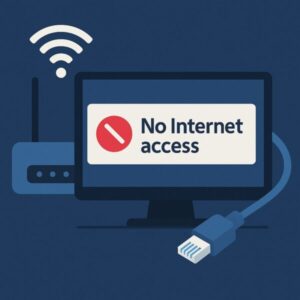
Few things are as frustrating as sitting down to work or stream a video and suddenly seeing the dreaded message on your Windows PC: “No Internet access.”
Sometimes your Wi-Fi icon shows full bars, yet no websites load. Other times, your Ethernet cable is firmly connected, but the internet is completely unreachable.
This problem isn’t unique to Windows 11—it also happens on Windows 10 and earlier versions. The good news? In most cases, you don’t need to be a tech expert to fix it. This guide covers the most common causes, step-by-step fixes, and advanced troubleshooting methods to get you back online quickly.
- 1 Why Windows Shows “No Internet Access”
- 2 Quick Fixes for “No Internet Access”
- 2.1 Solution 1: Restart Your Router and Modem
- 2.2 Solution 2: Verify DHCP (Automatic IP Assignment)
- 2.3 Solution 3: Refresh IP and DNS via Command Prompt
- 2.4 Solution 4: Update or Reinstall Network Drivers
- 2.5 Solution 5: Check Firewalls and Security Software
- 2.6 Solution 6: Use Public DNS Servers
- 2.7 Solution 7: Confirm ISP Status
- 3 Advanced Troubleshooting (When Basics Don’t Work)
- 4 Frequently Asked Questions (FAQ)
- 5 Quick-Reference Solution Table
- 6 Final Thoughts: Stay Prepared for Connectivity Issues
Why Windows Shows “No Internet Access”
Several underlying issues can trigger this error. Here are the most common culprits:
| Cause | Description |
|---|---|
| Router or modem malfunction | Temporary hardware glitches or overheating |
| DHCP failure | Unable to obtain an IP address automatically |
| Driver issues | Outdated or corrupted network adapter drivers |
| Firewall or antivirus | Security software blocking traffic unexpectedly |
| Incorrect settings | Misconfigured IP, DNS, or proxy settings |
| ISP outages | Service disruptions from your internet provider |
Let’s go through fixes for each cause, starting with the simplest.
Quick Fixes for “No Internet Access”
Solution 1: Restart Your Router and Modem
It may sound cliché, but power cycling your router and modem solves a surprising number of problems.
- Turn off both devices (unplug them if needed).
- Wait at least 30 seconds to discharge memory.
- Plug them back in and allow a full reboot (watch for lights to stabilize).
This method is especially effective after storms, ISP hiccups, or power surges.
Solution 2: Verify DHCP (Automatic IP Assignment)
Windows relies on DHCP (Dynamic Host Configuration Protocol) to request a valid IP address from your router. If DHCP fails, Windows cannot connect.
- Go to Settings → Network & Internet → Advanced network settings.
- Select your active adapter → View additional properties.
- Ensure both IP assignment and DNS assignment are set to Automatic (DHCP).
👉 If you see an address starting with 169.254.x.x, that’s Windows’ fallback (APIPA). It means DHCP failed—resetting it usually restores connectivity.
Solution 3: Refresh IP and DNS via Command Prompt
If DHCP looks correct but the connection still fails, refresh manually:
- Search for cmd, right-click Command Prompt, and choose Run as administrator.
- Enter these commands one by one:
ipconfig /releaseipconfig /renewipconfig /flushdns/releasedrops your current IP/renewrequests a fresh one/flushdnsclears cached DNS entries
Solution 4: Update or Reinstall Network Drivers
Drivers are often overlooked but critical.
- Press Win + X → Device Manager.
- Expand Network adapters.
- Right-click your adapter → Update driver → Search automatically.
If nothing updates, visit your manufacturer’s website (Intel, Realtek, Broadcom, or your laptop brand) and download the latest driver manually.
👉 Using Windows Update also sometimes fetches newer drivers.
Solution 5: Check Firewalls and Security Software
Overly aggressive security tools can block your connection.
- Temporarily disable antivirus/firewall software.
- In Windows, open Windows Security → Firewall & network protection and toggle it off briefly.
⚠️ If disabling restores access, review the rules or reinstall your antivirus cleanly.
Solution 6: Use Public DNS Servers
Sometimes the issue lies with your DNS server, not the connection itself. Switch to a reliable public DNS:
- Open your adapter’s properties (as in Solution 2).
- Select Use the following DNS server addresses.
- Enter:
- Primary:
8.8.8.8 - Secondary:
8.8.4.4
- Primary:
This Google DNS option is widely trusted and often resolves issues quickly.
Solution 7: Confirm ISP Status
Before spending hours troubleshooting:
- Test another device (phone, tablet) on the same network.
- Check your ISP’s website or social channels for outage notices.
- Try connecting your PC via a mobile hotspot to confirm whether the problem is ISP-related.
If all devices are down, the fault likely lies with your provider.
Advanced Troubleshooting (When Basics Don’t Work)
Advanced 1: Use Windows Network Reset
Windows 10/11 can reset all networking components in one click:
- Go to Settings → Network & Internet → Advanced network settings → Network reset.
- Click Reset now.
- Reboot.
⚠️ This removes Wi-Fi passwords, VPN profiles, and custom DNS settings—be prepared to re-enter them.
Advanced 2: Assign a Temporary Static IP
If DHCP is failing entirely, try assigning an IP manually:
- IP:
192.168.1.100 - Subnet Mask:
255.255.255.0 - Default Gateway:
192.168.1.1 - DNS:
8.8.8.8and8.8.4.4
This won’t fix the root problem but can get you online temporarily.
Advanced 3: Perform a Winsock Reset
Sometimes Windows’ networking stack itself is corrupted. Resetting Winsock restores defaults:
netsh winsock resetReboot afterward. Note that this may also clear proxy or VPN settings.
Frequently Asked Questions (FAQ)
Q1. Why does Wi-Fi say “Connected, No Internet” even with full signal?
The signal bars only confirm your PC is connected to the router. If the router itself can’t reach the internet (due to ISP failure or misconfigurations), Windows reports “No Internet” despite strong Wi-Fi.
Q2. Only one of my devices can’t connect, but others are fine. Why?
The issue is isolated to that PC. Focus on updating drivers, resetting network settings, and checking firewall/security conflicts.
Q3. What exactly is DHCP, and why does it matter?
Think of DHCP as your router assigning “seats” to each device on the network. Without it, your PC doesn’t know where to sit, so it can’t talk to the internet. If it fails, Windows assigns a random 169.254.x.x seat—which doesn’t actually connect you online.
Q4. Why does this problem keep coming back?
Recurring issues may point to hardware problems:
- Router overheating
- Faulty LAN cables
- A failing Wi-Fi card
Replacing outdated equipment often prevents repeat errors.
Quick-Reference Solution Table
| Fix Category | Action |
|---|---|
| Quick Checks | Restart router & modem, verify ISP status |
| Network Settings | DHCP auto, DNS servers, flush IP |
| Drivers | Update or reinstall adapter drivers |
| Security | Disable/review firewalls & antivirus |
| Advanced | Network reset, static IP, Winsock reset |
Final Thoughts: Stay Prepared for Connectivity Issues
“No Internet access” can strike anyone, at any time. The key is not to panic—most cases are resolved with a simple reboot or quick configuration change.
But if the issue repeats often, consider:
- Keeping an Ethernet cable handy as backup
- Using a USB Wi-Fi adapter if your laptop’s Wi-Fi card is aging
- Backing up important data before making major network changes
With the right steps, you can usually bring Windows back online in minutes. Bookmark this guide for the next time your PC decides to misbehave.
[Affiliate Disclosure] As an Amazon Associate, this site may earn from qualifying purchases.
Recommended Tools for a Stable Internet Connection
🔌 High-Speed Ethernet Cable – A reliable wired connection often solves Wi-Fi instability.
👉 Shop Ethernet cables on Amazon
📶 USB Wi-Fi Adapter – Replace failing Wi-Fi cards or boost weak signals.
👉 Browse Wi-Fi adapters on Amazon
💾 External SSD – Always back up your files before major network or system resets.
👉 Find external SSDs on Amazon
✅ You might also like:


